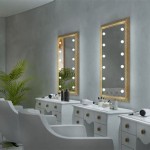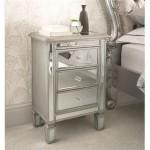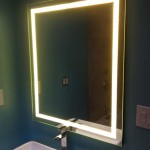Elevating Bathroom Aesthetics: The Allure of Mosaic Tile Behind the Mirror
The bathroom, traditionally a utilitarian space, has increasingly become a focal point for design expression within the home. Homeowners and designers alike are seeking innovative ways to inject personality and sophistication into this often-overlooked room. One increasingly popular trend is the incorporation of mosaic tile behind the bathroom mirror. This design choice offers a compelling blend of aesthetic appeal, practicality, and enduring value, transforming a functional area into a visually stunning sanctuary.
Mosaic tile, characterized by its small, individual pieces arranged to form a larger pattern or image, provides a versatile medium for artistic expression. Its application behind a bathroom mirror presents a unique opportunity to create a captivating backdrop that enhances the overall ambiance of the space. The reflective qualities of the mirror amplify the visual impact of the mosaic, creating a sense of depth and dimension. Moreover, the water-resistant nature of most mosaic tile materials makes it a practical choice for the moisture-prone environment of a bathroom.
A Spectrum of Design Possibilities
The versatility of mosaic tile allows for a virtually limitless range of design possibilities. From classic geometric patterns to intricate artistic murals, the choices are extensive. Consider these key design aspects when selecting mosaic tile for behind a bathroom mirror:
Material: Mosaic tiles are available in a wide array of materials, each offering unique aesthetic and functional characteristics. Glass mosaic tiles are renowned for their luminous quality and reflective properties, adding a touch of glamour and sophistication. Ceramic and porcelain tiles offer durability, water resistance, and a vast selection of colors and textures. Natural stone mosaics, such as marble, travertine, and slate, bring an organic and earthy element to the bathroom, creating a spa-like atmosphere. Metal mosaic tiles, often made of stainless steel or copper, introduce a contemporary and industrial aesthetic.
Color Palette: The color palette of the mosaic tile plays a crucial role in shaping the overall mood and style of the bathroom. Neutral tones, such as whites, beiges, and grays, create a serene and calming environment, while bold and vibrant colors add energy and personality. Monochromatic schemes offer a timeless and sophisticated look, while contrasting colors create visual interest and drama. Consider the existing color scheme of the bathroom and select mosaic tiles that complement or enhance it.
Pattern and Texture: Mosaic tiles can be arranged in a variety of patterns, from simple grids and stripes to complex geometric designs and intricate artistic murals. The texture of the tiles also contributes to the overall aesthetic appeal. Smooth, polished tiles create a sleek and modern look, while textured or matte tiles add depth and visual interest. Consider the size and shape of the bathroom and mirror when selecting a pattern. Smaller bathrooms may benefit from simpler patterns that don't overwhelm the space, while larger bathrooms can accommodate more intricate designs.
For example, a homeowner seeking a modern, minimalist bathroom might opt for a glass mosaic tile in a monochromatic color scheme with a simple geometric pattern. Conversely, a homeowner aiming for a more eclectic and artistic bathroom could choose a natural stone mosaic with a mix of colors, textures, and patterns.
Installation Considerations for Mosaic Tile
Proper installation is paramount to ensuring the longevity and aesthetic appeal of mosaic tile behind a bathroom mirror. While some homeowners may opt for professional installation, others may choose to undertake the project themselves. Regardless of the chosen approach, meticulous planning and execution are essential.
Surface Preparation: The surface behind the mirror must be clean, dry, and level. Any imperfections or irregularities should be addressed before installing the tile. This typically involves cleaning the surface with a suitable cleaner, patching any holes or cracks with a patching compound, and sanding the surface smooth. A primer should then be applied to the surface to improve adhesion.
Adhesive Selection: Choosing the appropriate adhesive is crucial for ensuring a strong and lasting bond between the mosaic tile and the substrate. A high-quality thin-set mortar specifically designed for mosaic tile is generally recommended. The type of thin-set mortar should be compatible with the type of tile being used (e.g., glass, ceramic, stone). It is critical to follow the manufacturer's instructions for mixing and application.
Cutting and Placement: Mosaic tile sheets are typically pre-mounted on mesh backing for easy installation. However, some cutting may be necessary to fit the tile around the mirror and any other fixtures. A wet saw with a diamond blade is recommended for cutting mosaic tile to ensure clean and precise cuts. When placing the tile, ensure that the grout lines are consistent and that the tiles are properly aligned. Use spacers to maintain uniform grout lines.
Grouting and Sealing: After the tile has been installed and the adhesive has cured, the grout lines should be filled with grout. Choose a grout color that complements the mosaic tile and the overall design of the bathroom. Apply the grout evenly and remove any excess grout with a grout float. Once the grout has cured, seal the grout lines with a grout sealer to protect them from moisture and stains. Additionally, it is prudent to seal any natural stone tiles to prevent water absorption and discoloration.
Professional installation often provides a more aesthetically pleasing and durable result, particularly for complex patterns or challenging spaces. Improper installation can lead to issues such as loose tiles, cracked grout, and water damage. Therefore, if unsure, consulting with a qualified tile installer is a prudent investment.
Enhancing Ambiance and Functionality
Beyond its aesthetic appeal, incorporating mosaic tile behind a bathroom mirror can enhance the functionality and ambiance of the space. Consider these practical benefits:
Reflectivity and Illumination: The reflective nature of many mosaic tile materials, particularly glass, can significantly enhance the illumination of the bathroom. The mirror amplifies the light reflected by the tile, creating a brighter and more inviting space. This is particularly beneficial in bathrooms with limited natural light.
Water Resistance and Durability: Most mosaic tile materials are naturally water-resistant, making them an ideal choice for the moisture-prone environment of a bathroom. They are also resistant to stains, mildew, and mold. This ensures that the tile will maintain its beauty and functionality for years to come. Properly installed and maintained mosaic tile can withstand the rigors of daily use and resist damage from water splashes and humidity.
Easy Maintenance: Mosaic tile is relatively easy to clean and maintain. Regular cleaning with a mild soap and water solution is typically sufficient to keep the tile looking its best. Avoid using abrasive cleaners or scouring pads, as these can damage the surface of the tile. Grout lines should be cleaned periodically with a grout cleaner and resealed as needed to prevent staining and mildew growth.
Visual Interest and Depth: The textured surface and intricate patterns of mosaic tile add visual interest and depth to the bathroom. This can help to create a more dynamic and engaging space. The mosaic serves as a focal point, drawing the eye and adding a touch of personality to the room. The interplay of light and shadow on the textured surface of the tile further enhances its visual appeal.
The integration of mosaic tile behind a bathroom mirror offers a transformative approach to bathroom design, seamlessly blending aesthetic enhancement with practical considerations. By carefully selecting materials, patterns, and installation techniques, homeowners and designers can create a visually stunning and functional space that elevates the overall ambiance of the bathroom.
Ultimately, the choice of mosaic tile is a personal one, reflecting individual tastes and preferences. However, by understanding the principles of design and installation, it is possible to create a truly unique and captivating bathroom that enhances the overall value and enjoyment of the home. The attention to detail in selecting and installing mosaic tile contributes significantly to the creation of a luxurious and personalized bathroom environment.

Diy Mosaic Tile Bathroom Mirror Centsational Style

Elegant Tile Backsplash Complements Vanity Mirror And Pendant Lights

Bathroom Decor Apartment Wall Tile Ideas

Diy Mosaic Tile Bathroom Mirror Centsational Style

Large Mirror Placed Against Mosaic Tile Wall In Earthy Hues Pastilha Banheiro Reforma Projeto Do

How To Mosaic Tile A Mirror Caffeine And Cabernet

Deco Mirror 24 In W X 30 H Rectangular Frameless Mosaic Tile Print Reeded Sea Glass Wall Bathroom Vanity Aqua 1205 The Home Depot

Mosaic Tile Behind Vanity Bathroom Designs Design Interior

Diy Mirror Frame With Glass Mosaic Tile Armchair Builder Blog Build Renovate Repair Your Own Home Save Money As An Owner

Carrara Venato Marble And Antique Mirror Glass Marrakech Arabesque Mosaic Tile Tilebuys








